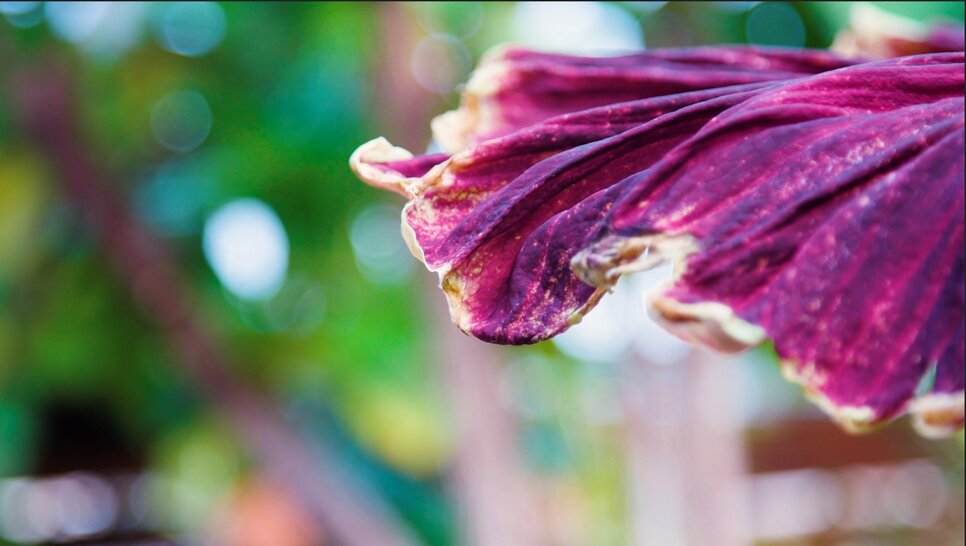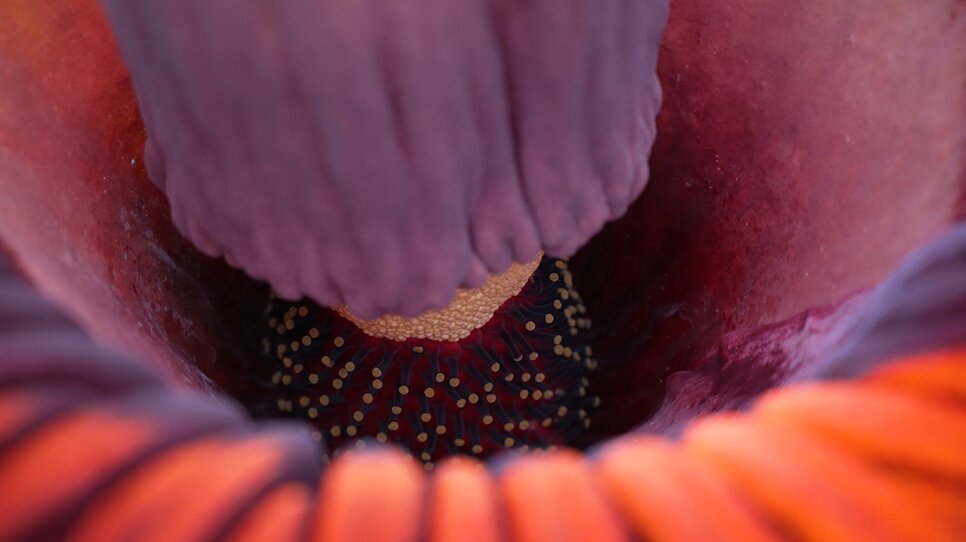‘Cheesy, fungus-y, death-y’: The science behind CSU’s corpse flower reveals a method to the madness
share

FORT COLLINS, Colo. — April showers brought May flowers, yet while the birds and the bees enjoyed the aromas of freshly-popped daisies, the beetles and flesh flies headed towards a fouler floral perfume.
“Cheesy, fungus-y, death-y.”
Brenner obtained the corpse flower — named in part for the flower’s distinct odor — through a “seed swap” with Ohio State University at a conference eight years ago.
Brenner, along with the help of various conservatory researchers and volunteers, has tended to the plant as it has cycled through growth, death and regrowth for years, as is typical of the rare species. So while the corpse flower can have a life span of 30 to 40 years, it may only ever bloom a few times.

“Cosmo” has been growing in the CSU Plant Facility Conservatory for nearly eight years.
Photo: Photo: Colorado State University Plant Facility Conservatory
Measuring from the top of the corm (the bulging underground stem from which the plant grows) to the top of the spadix (the flower’s large, protruding stalk), corpse flowers (Amorphophallus titanum) can stand as tall as 12 feet.
The Latin Amorphophallus Titanum, which roughly translates to “giant deformed phallus,” is derived from the shape of the spadix.
The Latin Amorphophallus Titanum, which roughly translates to “giant deformed phallus,” is derived from the shape of the spadix.
Offensive in name and in smell, the derision continues in the corpse flower’s appearance. Skirting the phallic stalk is a silky deep-crimson leaf or petal called the spathe.
The spathe’s coloring emulates the crimson-red hue of rotting flesh, which is the plant’s attempt to woo pollinating insects such as the carrion beetle and the flesh fly.
“This plant is intentionally trying to look like a dead animal,” said Brenner. “It is a perfect case of mimicry in the wild.”
Other corpse flower pollinators include birds and even rhinoceroses, according to Brenner, both of which will pick and redistribute the seeds that grow within the spathe of a blooming flower.
With such offensive flirting strategies, it might not come as a surprise to many that the corpse flower often struggles to repopulate. It is an endangered species, and there are thought to be fewer than 1,000 left in the wild.
However, other plants, like the skunk cabbage and the carrion plant, also expel foul odors to attract pollinators. So what makes pollination more difficult for the corpse flower?
One of the largest challenges they face is how long they last.

The corpse flower’s spathe (pictured) is meant to resemble the color of dead animal flesh.
Photo: Colorado State University Plant Facility Conservatory
Most of a corpse flower’s existence is spent in the “Leaf Stage'' of its life cycle. Here, the plant sprouts into a tall, single leaf, which can stretch upwards of fifteen feet. The leaf eventually dies, and the plant’s corm goes dormant for about six months until the process starts again.
However, after about seven to ten years in the Leaf Stage, the corpse flower’s corm will have stored sufficient energy to enter the Flower Stage, during which the plant may sprout hundreds of flowers within the leafy spathe.
During this cycle, the corm, which may weigh as much as 300 pounds, becomes intensely hot, reaching temperatures above 90 degrees. This heat powers the flower’s bloom.
Once a corpse flower has finished its Flower Stage, it will then re-enter the Leaf Stage. However, after its first bloom, the corpse flower’s corm is expected to have the energy to bloom again, typically within a span of three to five years.
Blossoming corpse flowers in their native habitat of Sumatra, Indonesia, may only stay open for about 24 hours, giving pollinators little time to visit. Importantly, it takes two flowers to reproduce, so while each corpse flower has both male and female anatomical parts, there must be at least two flowers open simultaneously for pollination to succeed.
These steep reproductive hurdles, matched with worsening deforestation and the expansion of destructive palm oil operations in their native habitats, have resulted in steep corpse flower population declines, decreasing by as much as 50% in the last 150 years.
In captivity, the reproductive window often stays open longer, sometimes up to two or three days. Without natural pollinators present, scientists must take things into their own hands, often making small incisions in the flower, then extracting and storing pollen for future use.
This is what Ohio State University was successfully able to do when they passed on the seedlings to Brenner. Researchers and volunteers at CSU extracted seeds “so we can start making our own baby Cosmos” in the future, according to one.
A rare corpse flower bloom offers much more than a few seedlings. Eager botanists and other researchers, including one with a specialization in decaying flesh and animals, surrounded CSU’s blossom, studying everything from the chemical makeup of the flower’s smell to the reactions of certain insects when exposed to the flesh-colored leaves.

Protected within the spathe are the corpse flower’s reproductive tools, both male and female.
Photo: Colorado State University Plant Facility Conservatory
Beyond research, the flower’s bloom gave many the sight and smell of a lifetime, as was the case for the 4,444 visitors who lined up around the block at CSU’s Plant Growth Facility Conservatory to catch a glimpse.
One of the most excited was Jennifer Litzau, a senior at Colorado State University in Fort Collins studying natural resource tourism and conservation biology. Litzau has been volunteering at the plant growth facility for a year and a half, during which she spent a significant amount of time tending to Cosmo the corpse flower.
She was even honored with naming the plant.
“[Cosmo] was my cat that passed away in 2018, so I’m kind of just remembering him as a corpse flower. Honoring him with new life,” said Litzau.
The plant growth facility is run completely by volunteers, and Litzau has found the conservatory to be a safe haven for studying, socializing and surrounding herself with plants.
“I love seeing [the plants] change,” said Litzau. “They’re very similar to animals and humans: they grow, they respond to their environment… so it’s fun to see them live that cycle.”
Litzau, a self-proclaimed plant lover, tends to around 150 house plants of her own when she’s not at the conservatory.
As Cosmo reached his eighth year, caretakers like Brenner and Litzau began growing concerned. A few months ago, Litzau decided to “up-pot” the corpse flower (moving the plant into a larger pot), with hopes that more room might prompt Cosmo to bloom.
It worked, and a short while later, Cosmo began growing at unprecedented rates, faster than many had expected.
“It was growing at 10 inches a day,” said Brenner. “That was not [our] educated guess. That was not [in line with the] gambling that people were doing in the back.”
With their corm at about 90 degrees, Cosmo sprouted overnight, and the following day, crowds gathered to enjoy the spectacle.

A line of enthusiastic spectators stretched down the block after Cosmo’s bloom was announced.
Photo: Chase McCleary, Rocky Mountain PBS
Litzau reveled in the much-deserved attention and appreciation being shown to the conservatory. She hopes that this will inspire more to visit the facility’s plants as well as the facility’s beloved turtle, Bruno.
Brenner emphasized that events like this underline the importance that local conservatories and botanical gardens play in the protection and preservation of rare and common plant species alike.
If Cosmo is to bloom again, it likely won’t be for another few years, according to Brenner. However, there are a number of other locations throughout Colorado that house corpse flowers.
The Denver Botanic Garden’s two corpse flowers, “Lil’ Stinker” and “Stinky”, last bloomed in 2022, which means another bloom may be nearing.
Other corpse flower names from across the country include Como Park’s “Horace,” San Francisco’s “Scarlet,” Appalachian State’s “Mongo,” and San Diego’s “Jack Smellington”.
Brenner noted that while plant lovers might not be able to grow a corpse flowers in their home gardens, paying a visit to local botanic gardens and giving a pinched-nose smile to even the most offensive of plant-friends like Cosmo make all the difference.